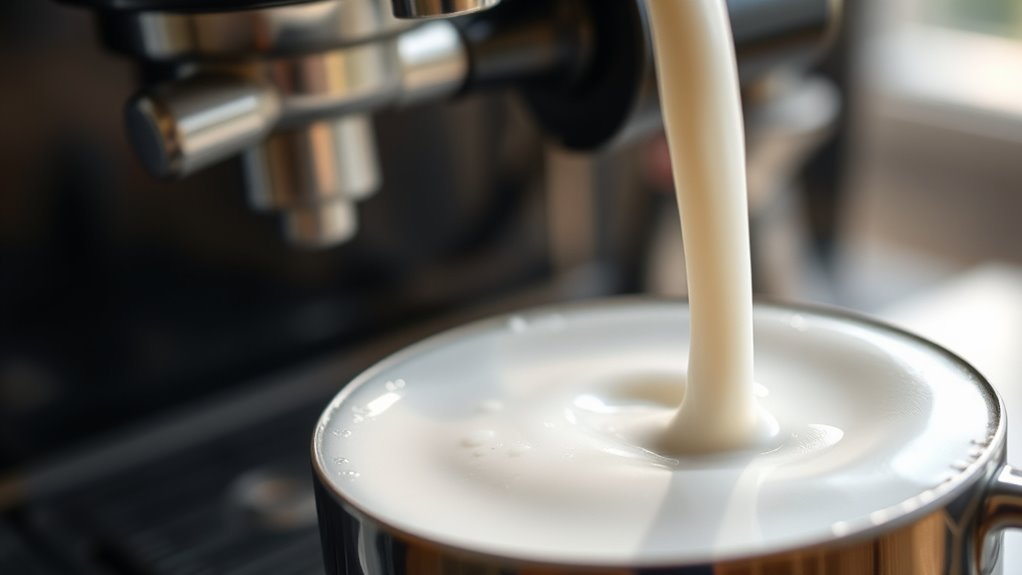Milk frothing works because proteins, fats, heat, and air work together to create stable, creamy foam. When you steam milk, heat causes proteins to trap tiny air bubbles, forming microfoam. Fats add richness and help the foam stay stable longer. Proper temperature and technique guarantee a silky texture and perfect froth for your coffee. To learn how to master this process and get expert results, keep going for more tips and insights.
Key Takeaways
- Milk proteins (casein and whey) trap air bubbles, forming stable foam during frothing.
- Proper heat (around 150°F) changes milk’s properties, helping create creamy, velvety microfoam.
- Fats in milk enhance creaminess and support foam stability, preventing collapse.
- Steaming introduces tiny air bubbles with heat, expanding and stabilizing foam structure.
- Technique—like positioning the steam wand and controlling temperature—directly impacts froth quality.
What Is Milk Frothing and Why Does It Matter?

Have you ever wondered what makes that creamy, velvety foam atop your latte so appealing? Milk frothing transforms ordinary milk into a smooth, airy foam that enhances both texture and flavor. This process creates a rich milk texture that feels luxurious on your palate, making each sip more enjoyable. Frothing also boosts flavor enhancement by releasing natural sugars and aroma compounds, giving your coffee a deeper, more complex taste. Proper frothing introduces tiny air bubbles that stabilize the foam, adding a silky consistency. Whether you prefer a cappuccino or a latte, understanding milk frothing helps you achieve the perfect balance of creaminess and flavor. Additionally, research into sound healing frequencies has shown that specific vibrations can influence cellular regeneration, which parallels how the right frothing technique can improve milk’s structure. Ultimately, it’s the science behind frothing that elevates your coffee experience from ordinary to extraordinary.
The Composition of Milk and Its Role in Frothing
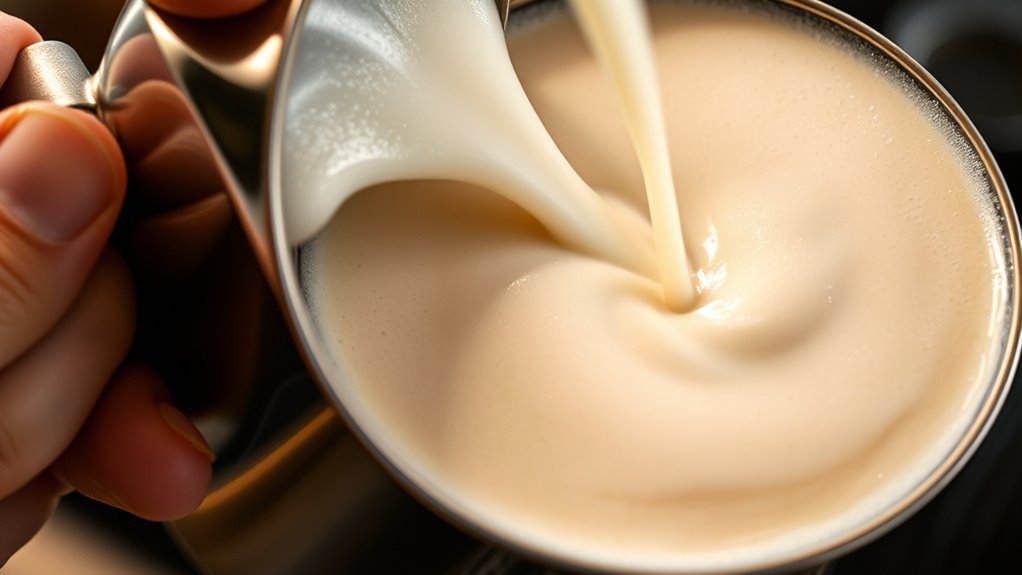
The composition of milk plays a crucial role in how well it froths, as its proteins, fats, and water content directly influence foam stability and texture. Milk proteins, especially casein and whey, form the structure that traps air and creates foam. Higher protein levels generally lead to a creamier, more stable froth. The fat content also affects frothing; skim milk produces lighter, less stable foam, while whole milk creates richer, velvety microfoam due to its fat particles. Water content affects the overall consistency, ensuring the milk can incorporate air efficiently. Understanding these components helps you choose the right milk type for your desired froth quality, ensuring a perfect coffee beverage every time. Additionally, knowing how milk composition influences frothing can help you troubleshoot issues like flat or unstable foam.
How Steam and Air Interact to Create Foam

When you steam milk, the interaction between hot steam and air is what transforms liquid into creamy foam. As the steam enters the milk, it introduces tiny air bubbles, which are essential for foam formation. Air pressure plays a pivotal role here; as you steam, the pressure around the milk decreases, causing air to expand and be absorbed into the liquid. This process encourages bubble formation, creating a network of microbubbles that give the milk its velvety texture. The key is balancing steam temperature and position to generate the right amount of air and pressure, resulting in a stable, glossy foam perfect for your coffee drinks. Proper technique and understanding of air absorption can help achieve a consistent and high-quality froth.
The Science of Protein and Fat in Milk
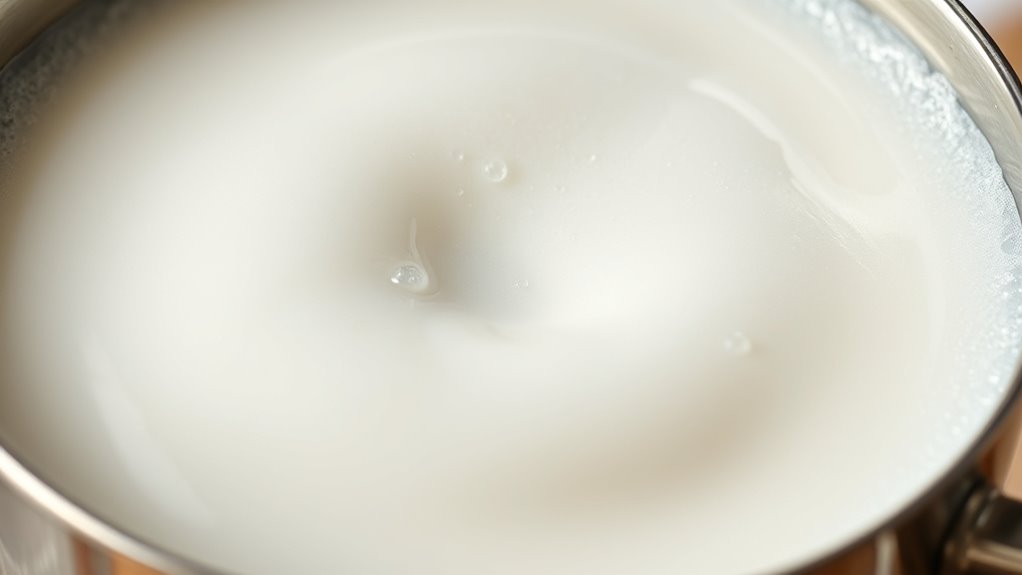
As you create foam with steamed milk, understanding its internal composition helps explain how it develops the right texture and stability. Milk contains proteins and fats that play vital roles during frothing. Proteins, mainly casein and whey, undergo protein interactions that trap air bubbles, forming stable foam. Fat contributes to fat stability, making the foam creamier and preventing collapse. Additionally, the type of milk used can influence the tuning of foam texture, affecting how well the foam holds its shape and consistency over time.
Techniques to Achieve the Perfect Froth
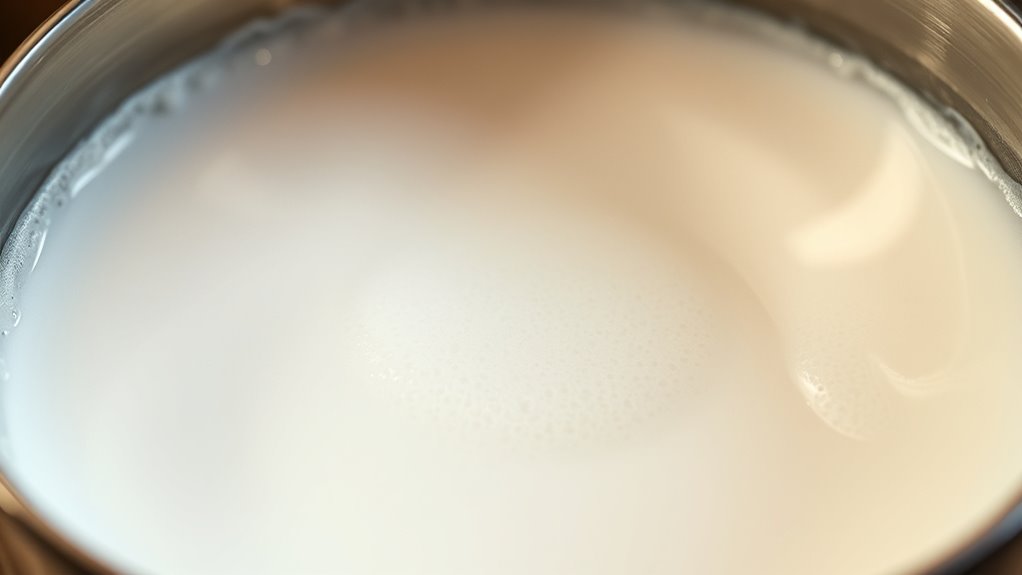
Achieving perfect froth requires precise technique and attention to detail. Start by selecting fresh, cold milk, which produces better foam. Use a steam wand to introduce air gently at the beginning, creating microfoam with a smooth, velvety froth texture. Keep the wand tip just below the surface to avoid large bubbles, and angle it slightly to incorporate air evenly. As the milk warms, submerge the wand deeper, continuing to heat until it reaches about 150°F (65°C). To craft beautiful latte art, aim for a glossy, silky microfoam without large bubbles. Proper technique ensures your froth is both stable and pourable, giving you the ideal canvas for intricate designs. Additionally, understanding the types of headphone jacks can help you choose compatible audio equipment for your setup. Proper technique ensures your froth is both stable and pourable, giving you the ideal canvas for intricate designs. Perfecting this skill enhances both the visual appeal and taste of your coffee.
Common Mistakes and How to Avoid Them

One common mistake is overheating the milk quickly, which can ruin the texture and flavor. Another issue is inconsistent frothing technique, leading to uneven foam and poor results. To avoid these, pay close attention to milk temperature and practice steady, controlled movements. Additionally, understanding the science behind milk frothing can help you achieve better results by tailoring your approach to the specific properties of milk.
Overheating Milk Quickly
Overheating milk quickly is a common mistake that can ruin your frothing results and even damage your equipment. When milk gets too hot, it loses its natural sweetness and frothing consistency suffers. To avoid this, focus on proper temperature control:
- Use a thermometer to keep milk below 150°F (65°C) for ideal frothing.
- Keep a close eye on the milk as it heats to prevent scorching or boiling.
- Move the steam wand or frothing pitcher away once the desired temperature is reached.
- Monitoring temperature control is essential for achieving the best froth without compromising milk quality.
Inconsistent Frothing Technique
Inconsistent frothing technique is a common mistake that leads to uneven texture and poor milk quality. When you don’t maintain a steady hand or control the frothing tools properly, the foam’s stability suffers, resulting in large bubbles or flat milk. To improve, focus on consistent positioning of your frothing wand or steam wand, ensuring even heat and air incorporation. Use the right frothing tools suited for your skill level; manual frothers require different techniques compared to automatic machines. Keep your hand steady and monitor the milk’s temperature to avoid overheating or under-frothing. Practicing steady, controlled motions will help create a uniform, glossy foam with ideal foam stability, making your drinks look and taste professional. Additionally, being aware of your passive voice detection can help you craft clearer, more direct instructions and descriptions in your brewing process.
Tips for Mastering Milk Frothing at Home
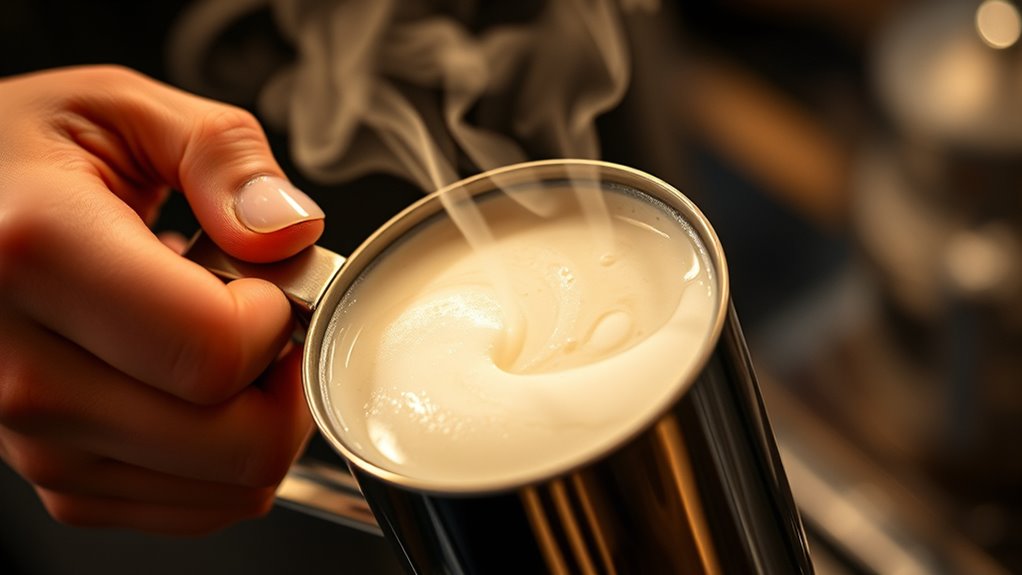
Mastering milk frothing at home may seem challenging, but with the right techniques, you can achieve barista-quality results. Focus on adjusting milk viscosity by choosing the right milk type and temperature. Proper frothing temperature, around 140°F to 150°F, ensures ideal foam without scorching the milk. Keep these tips in mind:
- Use cold, fresh milk to control viscosity and create stable foam
- Maintain a consistent frothing temperature for better microfoam
- Position the steam wand just below the milk surface to introduce air smoothly
- Understanding HEPA filtration principles can help you select the best milk for frothing, as certain milk types respond differently based on their composition and how they interact with heat and air.
Practicing these steps helps you develop a feel for milk behavior and enhances your frothing skills. With patience and attention to detail, you’ll consistently produce creamy, velvety milk perfect for your coffee creations.
Frequently Asked Questions
How Does Milk Temperature Affect Frothing Quality?
Milk temperature directly impacts frothing quality; when you heat milk to around 140°F to 160°F, it creates ideal froth with smooth, velvety texture. Too cold, and the milk won’t froth well, producing weak or absent foam. If you go too hot, above 170°F, the milk can scald, ruining the froth and flavor. Keeping the right milk temperature guarantees your frothing results are consistent and professional-looking.
Can Non-Dairy Milk Be Frothed Effectively?
Imagine swirling a cloud of velvety plant-based alternatives like almond or oat milk, transforming into a rich, frothy topping. You can definitely froth non-dairy milk effectively; it just requires a bit of attention. Dairy versus non-dairy options differ in protein content, but many plant-based alternatives froth beautifully with steamed heat and proper technique. With patience, your non-dairy creations can rival traditional froth in texture and fluffiness.
What Is the Ideal Milk Froth Texture for Different Drinks?
For different drinks, you want specific milk foam consistency to enhance each one. A silky, microfoam works best for lattes, creating smooth, drink-specific textures that blend seamlessly. Cappuccinos need thicker, denser foam to hold the classic dome, while flat whites benefit from a velvety, thinner foam. Adjust your frothing technique to achieve these textures, ensuring your milk foam consistency complements each beverage perfectly and elevates your coffee experience.
How Does Altitude Influence Milk Frothing Results?
Did you know that at higher altitudes, frothing consistency drops by up to 30%? Altitude effects make it harder to create stable, creamy milk foam because lower air pressure causes less steam pressure, reducing frothing power. As you go higher, the milk struggles to reach the same texture, so you might need to adjust your technique or use different equipment to achieve the perfect froth.
Are There Health Benefits to Using Specific Types of Milk?
Using specific types of milk can offer health benefits, especially if you have lactose intolerance. Almond milk is a popular choice because it’s dairy-free, low in calories, and free from lactose, helping you avoid digestive issues. Switching to almond milk may improve your gut health and reduce inflammation. Plus, many brands fortify their almond milk with vitamins and minerals, supporting your overall wellness without sacrificing taste or texture.
Conclusion
Now that you know the science behind milk frothing, you’re well on your way to creating barista-quality foam right at home. With a little practice, you’ll master the perfect froth that transforms your coffee into a masterpiece. Remember, understanding the magic of proteins, fats, and steam turns everyday milk into a velvety cloud of deliciousness. So go ahead—frothed milk is your secret weapon to elevate every sip to legendary status!
